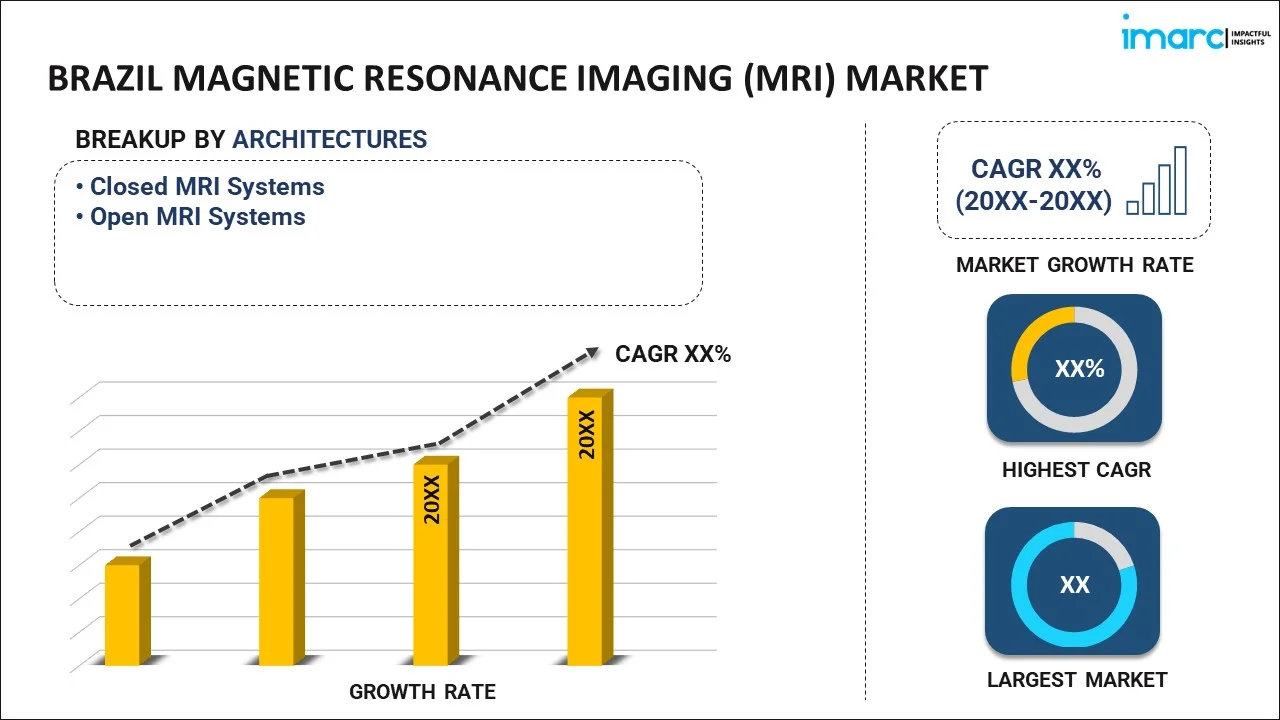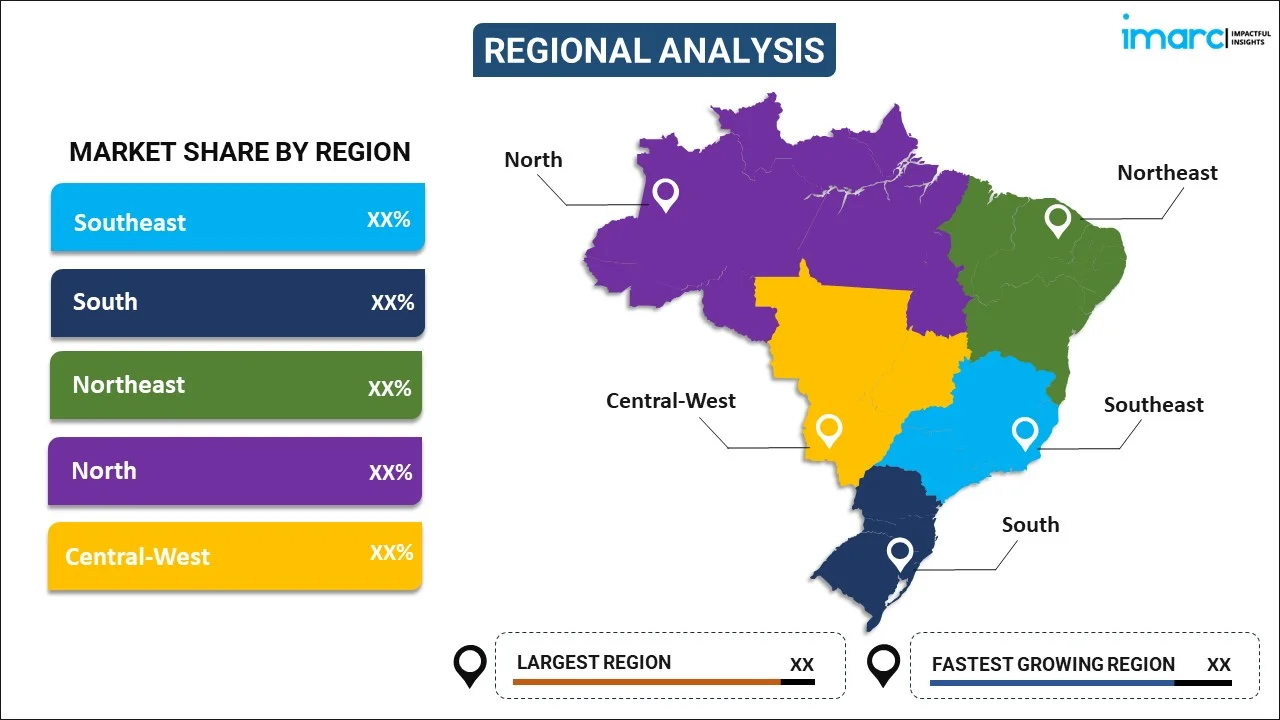
Brazil Magnetic Resonance Imaging (MRI) Market Report by Architecture (Closed MRI Systems, Open MRI Systems), Field Strength (Low Field MRI Systems, High Field MRI Systems, Very High Field MRI Systems and Ultra-High MRI Systems), Application (Oncology, Neurology, Cardiology, Gastroenterology, Musculoskeletal, and Others), and Region 2026-2034
Market Overview:
Brazil magnetic resonance imaging (MRI) market size reached USD 339.6 Million in 2025. Looking forward, IMARC Group expects the market to reach USD 515.6 Million by 2034, exhibiting a growth rate (CAGR) of 4.75% during 2026-2034. The increasing prevalence of diseases, recent technological advancements, escalating investment in modern healthcare equipment, rising procurement of advanced MRI machines, growing medical tourism activities in Brazil, and heightened public and medical awareness represent some of the key factors driving the market.
|
Report Attribute
|
Key Statistics
|
|---|---|
|
Base Year
|
2025
|
|
Forecast Years
|
2026-2034
|
|
Historical Years
|
2020-2025
|
|
Market Size in 2025
|
USD 339.6 Million |
|
Market Forecast in 2034
|
USD 515.6 Million |
| Market Growth Rate 2026-2034 | 4.75% |
Magnetic resonance imaging (MRI) is a medical imaging technique that uses magnetic fields and radio waves to create detailed images of the internal structures of the human body. It is comprised of essential components like the magnet, gradient coils, and radiofrequency antennas. MRI is manufactured using superconducting materials, copper, and other highly conductive materials. It is indispensable in various medical applications, including neurological imaging, cardiovascular analysis, cancer detection, musculoskeletal studies, and prenatal assessments. MRI offers multiple benefits, such as non-invasiveness, high-resolution imaging capability, absence of ionizing radiation, and its ability to differentiate between soft tissues. In addition, it is suitable for long-term studies and provides several advantages, such as the ability to produce multi-planar images, excellent contrast resolution, lower risk compared to X-rays, and versatility in imaging almost any part of the body.
Brazil Magnetic Resonance Imaging (MRI) Market Trends:
The increasing prevalence of diseases, such as cancer and neurological disorders across Brazil, which necessitates advanced imaging solutions, is propelling the market growth. Furthermore, recent technological advancements, such as high-field MRIs that offer faster scans and clearer images are catalyzing the market growth. In addition, the escalating investment in modern healthcare equipment by the government and private organizations to ensure access to optimal care for patients is contributing to the market growth. Along with this, the rising procurement of advanced MRI machines owing to the imposition of several policies and funding initiatives by the government aimed at bettering healthcare infrastructure is strengthening the market growth. Additionally, the growing medical tourism activities in Brazil, which are facilitating the demand for state-of-the-art diagnostic services, are positively impacting the market growth. Moreover, the heightened public and medical awareness concerning early diagnosis and preventive healthcare to reduce future complications, reduce healthcare expenditure, and improve clinical outcomes is driving the market growth. In line with this, the rising geriatric population across Brazil, resulting in increased healthcare needs, including MRI scans to manage various age-related complications, is supporting the market growth. Additionally, the widespread technique utilization for prenatal care, owing to its non-ionizing radiation, is catalyzing the market growth. Besides this, the rising number of telehealth facilitates and remote consultations, which necessitate MRI examinations for in-depth analysis, is positively impacting the market growth. In addition to this, the expanding insurance coverage for MRI procedures, which lowers the financial barrier for patients, is accelerating the market growth. Moreover, the rising collaboration with international medical technology firms, which helps in bringing advanced MRI machines to Brazil, is stimulating the market growth.
Brazil Magnetic Resonance Imaging (MRI) Market Segmentation:
IMARC Group provides an analysis of the key trends in each segment of the market, along with forecasts at the country level for 2026-2034. Our report has categorized the market based on architecture, field strength, and application.
Architecture Insights:

- Closed MRI Systems
- Open MRI Systems
The report has provided a detailed breakup and analysis of the market based on the architecture. This includes closed MRI systems and open MRI systems.
Field Strength Insights:
- Low Field MRI Systems
- High Field MRI Systems
- Very High Field MRI Systems and Ultra-High MRI Systems
A detailed breakup and analysis of the market based on the field strength have also been provided in the report. This includes low field MRI systems, high field MRI systems, and very high field MRI systems and ultra-high MRI systems.
Application Insights:
- Oncology
- Neurology
- Cardiology
- Gastroenterology
- Musculoskeletal
- Others
A detailed breakup and analysis of the market based on the application have also been provided in the report. This includes oncology, neurology, cardiology, gastroenterology, musculoskeletal, and others.
Regional Insights:

- Southeast
- South
- Northeast
- North
- Central-West
The report has also provided a comprehensive analysis of all the major regional markets, which include Southeast, South, Northeast, North, and Central-West.
Competitive Landscape:
The market research report has also provided a comprehensive analysis of the competitive landscape in the market. Competitive analysis such as market structure, key player positioning, top winning strategies, competitive dashboard, and company evaluation quadrant has been covered in the report. Also, detailed profiles of all major companies have been provided.
Brazil Magnetic Resonance Imaging (MRI) Market Report Coverage:
| Report Features | Details |
|---|---|
| Base Year of the Analysis | 2025 |
| Historical Period | 2020-2025 |
| Forecast Period | 2026-2034 |
| Units | Million USD |
| Scope of the Report | Exploration of Historical Trends and Market Outlook, Industry Catalysts and Challenges, Segment-Wise Historical and Future Market Assessment:
|
| Architectures Covered | Closed MRI Systems, Open MRI Systems |
| Field Strengths Covered | Low Field MRI Systems, High Field MRI Systems, Very High Field MRI Systems and Ultra-High MRI Systems |
| Applications Covered | Oncology, Neurology, Cardiology, Gastroenterology, Musculoskeletal, Others |
| Regions Covered | Southeast, South, Northeast, North, Central-West |
| Customization Scope | 10% Free Customization |
| Post-Sale Analyst Support | 10-12 Weeks |
| Delivery Format | PDF and Excel through Email (We can also provide the editable version of the report in PPT/Word format on special request) |
Key Questions Answered in This Report:
- How has the Brazil magnetic resonance imaging (MRI) market performed so far and how will it perform in the coming years?
- What is the breakup of the Brazil magnetic resonance imaging (MRI) market on the basis of architecture?
- What is the breakup of the Brazil magnetic resonance imaging (MRI) market on the basis of field strength?
- What is the breakup of the Brazil magnetic resonance imaging (MRI) market on the basis of application?
- What are the various stages in the value chain of the Brazil magnetic resonance imaging (MRI) market?
- What are the key driving factors and challenges in the Brazil magnetic resonance imaging (MRI)?
- What is the structure of the Brazil magnetic resonance imaging (MRI) market and who are the key players?
- What is the degree of competition in the Brazil magnetic resonance imaging (MRI) market?
Key Benefits for Stakeholders:
- IMARC’s industry report offers a comprehensive quantitative analysis of various market segments, historical and current market trends, market forecasts, and dynamics of the Brazil magnetic resonance imaging (MRI) market from 2020-2034.
- The research report provides the latest information on the market drivers, challenges, and opportunities in the Brazil magnetic resonance imaging (MRI) market.
- Porter's five forces analysis assist stakeholders in assessing the impact of new entrants, competitive rivalry, supplier power, buyer power, and the threat of substitution. It helps stakeholders to analyze the level of competition within the Brazil magnetic resonance imaging (MRI) industry and its attractiveness.
- Competitive landscape allows stakeholders to understand their competitive environment and provides an insight into the current positions of key players in the market.
Need more help?
- Speak to our experienced analysts for insights on the current market scenarios.
- Include additional segments and countries to customize the report as per your requirement.
- Gain an unparalleled competitive advantage in your domain by understanding how to utilize the report and positively impacting your operations and revenue.
- For further assistance, please connect with our analysts.
 Request Customization
Request Customization
 Speak to an Analyst
Speak to an Analyst
 Request Brochure
Request Brochure
 Inquire Before Buying
Inquire Before Buying




.webp)




.webp)












